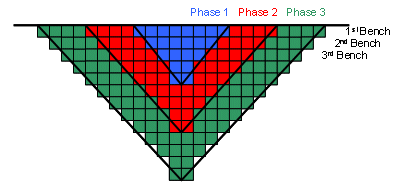What Are Ultimate Pits?
Also known as 'phases', pseudoflow pits are a series of nested pit geometries calculated to determine the most effective way of following the first basic principle of NPV scheduling; to mine the highest value ore first.
This method is used to determine the 'ultimate pit' for given commodity prices and mining cost parameters as well as the fundamental engineering constraints of the pit wall slope. The ultimate pit is the theoretical phase structure that gives the highest gain when balanced against mining cost. There are many factors that can affect the calculation of an ultimate pit, for example, it is often a reality that more valuable resources, in terms of grade, are located deeper underground than lower grade resources. As such, it may only be viable to mine an area where grade has been estimated at, say, 3 g/t and the commodity price (non-discounted) is $350 per ounce. If these conditions are met, the operation is viable. If, however, the commodity price drops to $300 per ounce (that is, below this minimum cutoff grade), it may no longer be viable to mine that particular area.
Nested Pits vs. Economic Conditions
For this reason, each commodity price can potentially give rise to a different pit geometry, as more or less blocks become economically viable. By varying the economic parameters in percentage increments a set of nested pits can be generated where each pit represents the ultimate pit of maximum value corresponding to the particular price or cost conditions, for example:

In the diagram above, the blue area (the smallest pit), is the one that represents the best value that is possible in the early stages of mining as it is the pit that would still be valuable even under the worst economic conditions (that is, a low commodity price). The green (largest) pit represents the pit with the longest life under the best economic conditions. As a consequence, nested pits are in the order of highest to lowest value per tonne mined. In this case, the green area represents the ultimate pit for a higher commodity price.
Note that the colours shown represent final pit extents - green is a deeper and wider overall pit than the red, for example. More ore can be mined, as the ore is more valuable under higher commodity pricing conditions. As commodity prices are volatile, the extent of pit phases is often refined in line with new economic conditions.
The difference between each pit shell and the next is considered to be a “phase”. Considering that realizing the best value first is a basic principle of maximizing NPV the order of the phases represents the first high level categorization of the value and the first stage of determining the Optimal Extraction Sequence for the ultimate pit.
Related topics and activities

